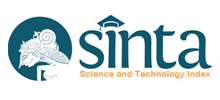Keywords
interactive multimedia learning, Merapi, vulcanism, geography, android base
Document Type
Article
Abstract
This study aims to anticipate the loss of learning for students in the geography education field practice in the southern region of Merapi Volcano during the Covid-19 Pandemic era by developing Android-based interactive learning multimedia as a medium as well as teaching materials. The development uses the ADDIE method (Analysis, Design, Development, Implementation, and Evaluation). Product feasibility was assessed by six material and media expert lecturers and 10 geography education students as users. The result of the development is an interactive multimedia with flipped book combined with Adobe Flash Maker on Android, with the name "Merapi Volcano Imaginary". The contents of the material are geographic physical and socio-economic studies on ten study areas, namely: Tugu Yogyakarta, Lava Breccia, Sambisari Temple, Merapi Museum, Plawangan Hill, Mbah Maridjan Museum, Kaliadem Bunker, Gendol River, Museum of "Sisa Hartaku", upper River Section "Opak". The experts rated the media and material in the Excellent category. The results are the same by users for aspects: readability, cohesiveness, attractiveness, coloring, material understanding, material order, and metacognitive value. All respondents stated that multimedia was very feasible and effective as a medium and teaching material for field practice of geography education in the southern region of Merapi Volcano
First Page
271
Last Page
286
Page Range
271-286
Issue
2
Volume
52
Digital Object Identifier (DOI)
10.21831/informasi.v52i2.56377
Source
56377
Recommended Citation
Nursa'ban, M., Mukminan, M., Widyastuti, M., Langit, D. S., & Anwar, M. C. (2022). "Merapi Volcano Imaginary" an alternative multimedia learning geography in the south region of Merapi volcanism. Informasi, 52(2), 271-286. https://doi.org/10.21831/informasi.v52i2.56377
References
Arsyad, A . (2010) Media Pembelajaran. PT Raja Grafindo Persada
Bednarz, R.S, and Petersen. J.F. (1994): A decade of Reform in Geography Education: Inventory and Prospect. Indiana, Pa.: National Council for Geographic Education
Borg,W.R & Gall, M.D. (1983). Educational Research: An Introduction. London: Longman. Inc.
Bosco, A. M., & Ferns, S. (2014). Embedding of authentic assessment in work-integrated learning curriculum. Asia-Pacific Journal of Cooperative Education, 15(4), 281-290.
Branch. M. R. (2009). Instructional design: the ADDIE approach. New York: Springer.
Dale, E. (1967). The historical setting of programmed instruction. In P. C. Lange (Ed.), Programmed instruction: Sixty-sixth yearbook of the National Society for the Study of Education, Part 2 (pp. 28-54). Chicago: University of Chicago Press
Flynn, K. C. (2018) "Improving spatial thinking through experiential-based learning across international higher education settings," International Journal of Geospatial and Environmental Research: Vol. 5: No. 3, Article 4. Retrieved from: https://dc.uwm.edu/ijger/vol5/iss3/4
Grzyb, T, and Dolinski, D. (2021). The Field Study in Social Psychology: How to Conduct Research Outside of a Laboratory Setting?. London: Routledge. DOI: https://doi.org/10.4324/9781003092995
Haggett, Peter. (2001). Geography: a global synthesis. England: Pearson Education,
Hamalik, Oemar, (1989). Media Pendidikan. Bandung: UPI.
Idris, Husni. (2008). Pengembangan Multimedia Pembelajaran Berbantuan Komputer. (online). Tersedia: http:/Jurnaliqro.files.wordpress.com /2008/08/05
Johnson, E.B. (2001). Contextual teaching and learning: What It Is and Why It's Here to Say. Corwin Publisher. ISBN-13:978-0761978657.
Khotimah, N., Sumunar, D.R.S., Purwantara, S., Prabintoro, N.S., Ibrahim, M.H., Nayan, N. (2022). The role of social media as a communication facility for hydrometeorological disasters in shallot farming activities. Informasi Vol. 52, No. 1. pp. 47-62 doi: http://doi.org/10.21831/informasi.v52i1.50115. 47-62
Lambert, D. & Morgan, J. (2010). Teaching geography (11-18): A conceptual approach. New York: Open University Press
Munandar, A. (2017), Perbandingan Kegiatan Fieldstudy di Program Study/Jurusan Pendidikan Geografi (Study di UNJ, UPI, UNESA, UNY), Jakarta: Univesitas Negeri Jakarta
Munandar, A., Maryani, E., Rohmat, D., & Ruhimat, M. (2020). Establishing the Professionalism of Geography Teacher through Authentic Assessment Field Study. International Journal of Instruction, 13(2), 797-818. https://doi.org/10.29333/iji.2020.13254a
Nursa'ban, M. (2013). Field study: Pembelajaran inovatif materi-materi fisiografis Mata pelajaran geografi SMA. Prosiding Pertemuan Ilmiah Tahunan (PIT) XVI Ikatan Geografi Indonesia. Banjarmasin, 2-3 November 2013. ISBN: 978-602-1322-00-0.
Riyanto, Y. (2009). Paradigma Baru Pembelajaran. Jakarta : Raja Grafika
Rusman. (2011). Model - Model Pembelajaran. Jakarta: PT. Raja grafindo Persada.
Sanjaya, W. (2010). Strategi Pembelajaran Berorientasi Standar Proses. Pendidikan. Jakarta: Kencana
Sardiman, A.M. (2009). Interaksi dan Motivasi Belajar Mengajar. Jakarta. PT. Rajawali Pers.
Seperti Indonesia, Negara-Negara G20 Dorong Pembelajaran Tatap Muka: The Ministry of Education and Culture, (2022, Juli 08). Accessed https://www.kemdikbud.go.id/main/blog/2022/07/seperti-indonesia-negaranegara-g20-dorong-pembelajaran-tatap-muka
Sigit, dkk. (2008). Pengembangan Pembelajaran dengan Menggunakan Multimedia Interaktif Untuk Pembelajaran yang Berkualitas. Karya Tulis Ilmiah. Universitas Negeri Semarang.
Sofyan, A. F. (2008). Digital Multimedia: Animasi, Sound, Editing, dan Vidio Animasi.
Sugiyanto. (2010). Model-model Pembelajaran Inovatif. Surakarta: Yuma Pressindo
Sutopo, A. H. (2003). Multimedia Interaktif Flash. PT Graha Ilmu. Yogyakarta.
Taylor, P.J., and Keefe, P, (2021) a Praise of Geography as a field of study for the climate emergency. Royal Geographical Society. Vol. 187 issue 4 P: 394-401. DOI: 10.1111/geoj.12404

